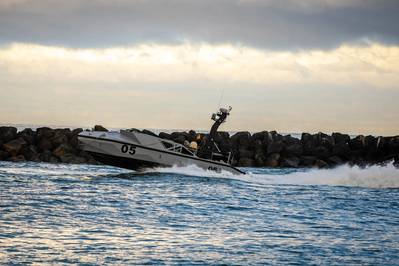Sea Drone Warfare has Arrived, and the US is Floundering
The U.S. Navy's efforts to build a fleet of unmanned vessels are faltering because the Pentagon remains wedded to big shipbuilding projects, according to some officials and company executives, exposing a weakness as sea drones reshape naval warfare.
The lethal effectiveness of sea drones has been demonstrated in the Black Sea where Ukraine has deployed remote-controlled speed boats packed with explosives to sink Russian frigates and minesweepers since late 2022.
Yemeni-backed Houthi rebels have employed similar vessels against commercial shipping in the Red Sea in recent months, albeit without success.
These tactics have caught the attention of the Pentagon, which is incorporating lessons from Ukraine and the Red Sea into its plans to counter China's rising naval power in the Pacific, Pentagon Spokesman Eric Pahon told Reuters.
In a signal of the Pentagon's intent, Deputy Secretary of Defense Kathleen Hicks announced an initiative in August - named Replicator - to deploy hundreds of small, relatively cheap air and sea drones within the next 18-24 months to match China's growing military threat.
This public show of commitment masks years of hesitation by the U.S. Navy to build a fleet of unmanned vessels despite repeated warnings this was the future of maritime warfare, according to interviews with a dozen people with direct knowledge of the U.S. sea drone plans, including Navy officers, Pentagon officials, and sea drone company executives.
Two Navy sources and three executives at sea drone manufacturers said the biggest impediment to progress has been a Department of Defense (DoD) budget process that prioritizes big ships and submarines built by legacy defense contractors.
"At some point, you hit the D.C. problem," said Philipp Stratmann, CEO at Ocean Power Technologies (OPT), a New Jersey-based firm that supplies the U.S. Navy with the WAM-V, an autonomous surface drone.
"You hit the fact that there is a military industrial complex that has the best lobbyists and knows exactly how the money flows and contracting works in the DOD."
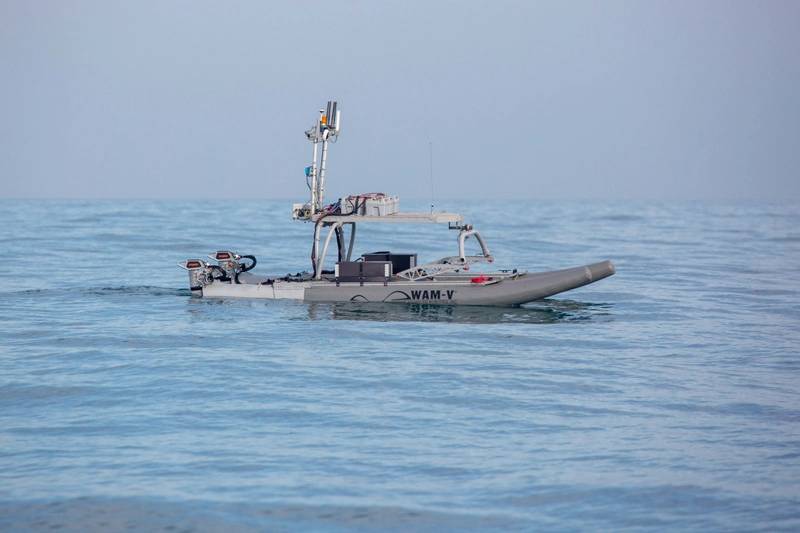 A WAM-V unmanned surface vessel operates in the Arabian Gulf, Nov. 29, 200 during Digital Horizon 2022. The three-week unmanned and artificial intelligence integration event involved employing new platforms in the region for the first time. (Photo: Brandon Murphy / U.S. Army)
A WAM-V unmanned surface vessel operates in the Arabian Gulf, Nov. 29, 200 during Digital Horizon 2022. The three-week unmanned and artificial intelligence integration event involved employing new platforms in the region for the first time. (Photo: Brandon Murphy / U.S. Army)
A Navy spokesperson said it "acquires capabilities based on fleet demand signals", referring to the messages headquarters receive from commanders at sea.
The Navy has a budget of $172 million this year for small and medium-sized underwater sea drones, falling to $101.8 million in 2025, the spokesperson said. That's a tiny fraction of the $63 billion Navy procurement budget proposed by President Joe Biden's administration for 2025.
Military sea drones can range from missile-armed speed boats to minehunting miniature submarines and solar-powered sailboats equipped with high-definition spy cameras, underwater sensors and loudspeakers used to holler warnings at enemy ships.
But when the Navy has deployed sea drones on reconnaissance missions in recent years, it hasn't always had the fleet expertise to use them, the two Navy sources said, asking not to be named due to the sensitivity of the matter.
There aren't enough Navy sailors trained to pilot drones or to analyze vast swathes of data sent back from the craft's cameras and sensors, the sources said.
The spokesperson said the Navy was in the process of improving its data collection and analysis from sensors.
Pentagon spokesman Pahon said the DoD has been "laser-focused on accelerating innovation over the last three years", including the use of sea drones.
Acknowledging budget challenges, Pahon said the Pentagon was using innovative ways to cross "the valley of death", a term used to describe the torturous approval process new inventions travel through to be purchased in large quantities.
Replicator
One example Pahon cited was the Replicator program: the short-term, $500 million-a-year project is designed to cut through bureaucracy and fast track the deployment of thousands of cheap aerial and sea drones.
These drones will be used to match China's rapidly-growing air and naval power in the Asia-Pacific region, the Pentagon's Hicks said at the project's launch in August. She said Replicator is being funded mainly by reallocating funds from the existing Pentagon budget.
As part of the initiative, the Pentagon in January issued a solicitation for private companies to deliver small sea drones to the Navy, demanding production capacity of 120 vessels per year, with deployment beginning in April 2025.
Duane Fotheringham, president of unmanned systems at Huntington Ingalls Industries (HII), the largest U.S. military shipbuilder, acknowledged the Pentagon and Navy had shown their "intent" to accelerate the deployment of sea drones but he said the industry wanted to see long-term funding in the defense budget.
"We hear the demand signal … but we all have to work together very closely to understand what that demand is and when it will be available," Fotheringham told Reuters.
At a cost ranging between $1 million and $3 million apiece, according to Navy and defense contractor sources, drones offer a relatively cheap and fast way to expand the Navy's fleet, especially as several large traditional shipbuilding projects - like a new class of frigate warships - are running years behind schedule.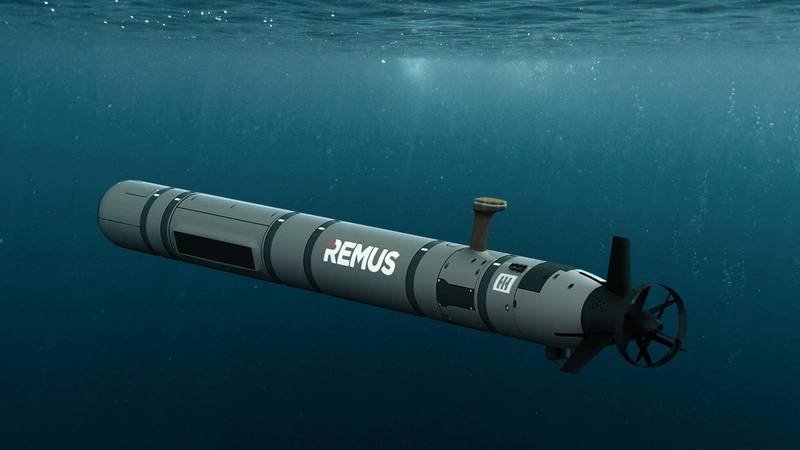 Rendering of a HII Remus unmanned underwater vehicle (Image: HII)
Rendering of a HII Remus unmanned underwater vehicle (Image: HII)
The U.S. is testing using robot ships in active combat scenarios. But their more immediate use is for missions that are too costly and numerous for manned naval fleets.
This includes maritime surveillance, minehunting, and protecting critical undersea infrastructure, like gas pipelines and fiber-optic cables, four drone companies told Reuters.
Swarms of small sea drones could also act as a shield for valuable crewed assets like aircraft carriers and submarines, and tangle up troop-carrying ships in the event China tries to invade Taiwan, said Bryan Clark, an advisor to the Navy on autonomous craft and a senior fellow at the Hudson Institute - a think tank headquartered in Washington.
Clark estimates the Navy has around 100 small drones for use on the ocean surface and another 100 underwater drones, while China has a similar-sized autonomous force that is growing fast. The Navy spokesperson declined to comment on how many drones it has in operation.
"Ukraine has shown how effective they can be and how they can be employed in current operations," Clark said. "The U.S. Navy needs to embrace that lesson and field combat (sea drones) right away."
The Navy's 5th fleet, which operates out of Bahrain, has been testing unmanned vessels for three years, led by its Task Force 59 unit.
The project has deployed surveillance drones built by private firms, including startups, as well as those backed by defense heavyweights like Lockheed Martin and HII.
"The situation in the Red Sea gives the work of Task Force 59 added urgency and we look forward to fielding solutions to help counter Houthi malign behavior," Colin Corridan, commander of the task force, told Reuters.
Missile test
In October, the Navy carried out its first live missile test from an unmanned speedboat in the Arabian Peninsula.
The T38 Devil Ray, built by Florida-based sea drone firm MARTAC, successfully launched a miniature missile system to destroy a target boat, with a human operator ashore giving the order, according to a Navy announcement and video.
MARTAC's Chief Marketing Officer, Stephen Ferretti, referred questions about the operation to the Navy.
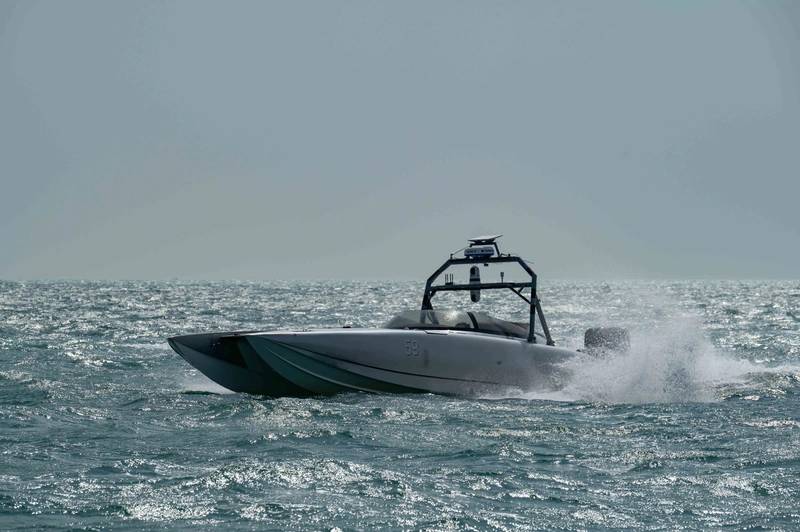 A MARTAC T-38 Devil Ray unmanned surface vessel, attached to U.S. 5th Fleet’s Task Force 59, sails in the Arabian Gulf, Oct. 26, 2023 (Photo: Jacob Vernier / U.S. Navy)
A MARTAC T-38 Devil Ray unmanned surface vessel, attached to U.S. 5th Fleet’s Task Force 59, sails in the Arabian Gulf, Oct. 26, 2023 (Photo: Jacob Vernier / U.S. Navy)
The use of unmanned vessels was expanded to the Navy's 4th Fleet in central America last year where they have been used to crack down on human smuggling off the northern coast of Haiti.
One of the companies operating there is Saildrone, a California-based firm that makes wind-, solar- and diesel-powered autonomous vessels that collect images and data with cameras and sensors.
Saildrone has circumnavigated Washington's funding politics. Because the company operates and maintains its own vessels, and charges a service fee for the data they collect, the Navy can pay to use the drones out of its operating expenses rather than procurement budget.
Saildrone launched the Surveyor, its largest vessel, which has been tailored for the military, at an event in March attended by Chief of Naval Operations Lisa Franchetti.
The drone firm, which also supplies coast guards and ocean survey departments, has a fleet of 130 vessels and is building several more every month, said Richard Jenkins, the company's founder.
"Right now, we are struggling to keep up with demand," Jenkins told Reuters in an interview. He declined to comment on how much Saildrone charges the Navy.
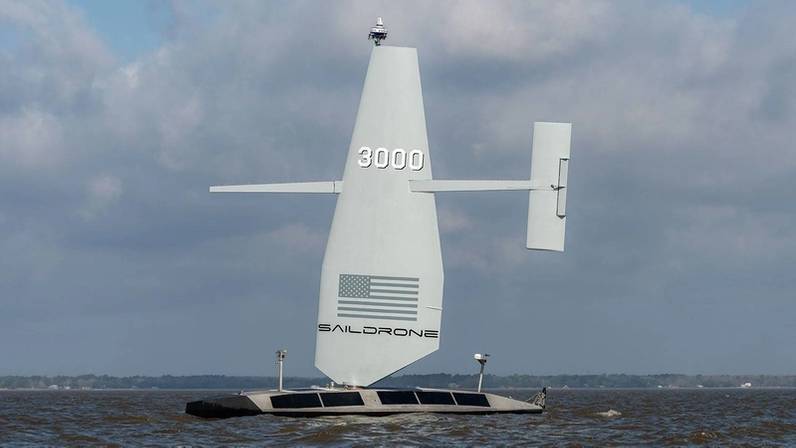 A next-gen Saildrone Surveyor USV (Photo: Saildrone)
A next-gen Saildrone Surveyor USV (Photo: Saildrone)
Ocean Aero builds the autonomous Triton vessel, which can move on the surface or underwater to collect data and hunt for mines using sensors. The company, which is backed by Lockheed Martin, opened a 63,000 feet manufacturing facility in Gulfport, Mississippi last October that is capable of churning out 150 Tritons a year.
Lockheed Martin did not respond to a request for comment.
HII was awarded a contract last October to build nine small underwater drones for the U.S. Navy's Lionfish program, with the potential for this to rise to 200 vehicles over the next five years. The contract could total $347 million, although that is far from guaranteed.
The Lionfish program - which is focused on the Indo-Pacific where the U.S. is vying for control with China - is based on HII's Remus 300, a minehunting drone that can be launched like a torpedo from a crewed ship or submarine.
These programs are proof that the Pentagon is trying to move faster to deploy sea drones, spokesman Pahon told Reuters.
"We know we need to keep pushing to stay ahead," he said.
 A Triton unmanned surface vessel (USV) rests ashore in San Diego during Integrated Battle Problem (IBP) 24.1, March 08, 2024. IBP 24.1 is a U.S. Pacific Fleet experiment, executed by U.S. 3rd Fleet, operationalizing multi-domain employment of unmanned systems to create fleet warfighting advantages. (Photo: Ian Delossantos / U.S. Navy)
A Triton unmanned surface vessel (USV) rests ashore in San Diego during Integrated Battle Problem (IBP) 24.1, March 08, 2024. IBP 24.1 is a U.S. Pacific Fleet experiment, executed by U.S. 3rd Fleet, operationalizing multi-domain employment of unmanned systems to create fleet warfighting advantages. (Photo: Ian Delossantos / U.S. Navy)
(Reuters - Reporting by Joe Brock in Singapore and Mike Stone; Editing by Daniel Flynn)



